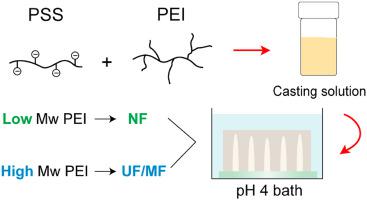Journal of Membrane Science ( IF 8.4 ) Pub Date : 2021-02-06 , DOI: 10.1016/j.memsci.2021.119114 Muhammad Irshad Baig , Putu Putri Indira Sari , Jiaying Li , Joshua D. Willott , Wiebe M. de Vos

|
pH shift induced Aqueous phase separation (APS) is a novel and more sustainable water-based approach to create microfiltration, ultrafiltration, and nanofiltration membranes. APS allows for control over membrane pore size and structure in ways analogous to traditional non-solvent induced phase separation (NIPS). Unfortunately, existing APS approaches require extreme pH shifts (from pH 14 to pH 1) to obtain successful membranes, limiting their applicability for large scale production. Here we demonstrate that APS membranes, with tunable pore sizes ranging from ~80 nm to dense nanofiltration type, can be prepared using a mild pH shift (pH 12 to pH 4) based on the complexation of poly(styrene sulfonate) (PSS) and branched polyethyleneimine (PEI) in acetate buffer coagulation baths. The molecular weight of PEI, the concentration and the pH value of the buffer solution, and the concentration of glutaraldehyde cross-linking agent were systematically varied to control and optimize the membrane fabrication conditions. It was found that tight nanofiltration membranes having a molecular weight cut-off of ~200 g mol−1 and excellent salt (97% MgCl2) and micropollutant retentions (~96%) could be prepared alongside ultra/microfiltration type membranes with an average pore size of ~60 nm. These results indicate that APS membranes with tunable pore sizes can be prepared under mild pH conditions with excellent control over separation properties.
中文翻译:

通过温和的pH位移诱导PSS和PEI的聚电解质络合制备可持续的水相分离膜
pH转变诱导的水相分离(APS)是一种新颖且更具可持续性的水基方法,用于创建微滤,超滤和纳滤膜。APS允许以类似于传统非溶剂诱导相分离(NIPS)的方式控制膜的孔径和结构。不幸的是,现有的APS方法需要极端的pH转换(从pH 14到pH 1)才能获得成功的膜,从而限制了其在大规模生产中的适用性。在这里,我们证明,基于聚(苯乙烯磺酸盐)(PSS)和聚苯乙烯的络合作用,可以使用温和的pH转换(pH 12至pH 4)制备孔径范围从〜80 nm到致密纳滤类型的APS膜。乙酸缓冲液凝固浴中的支链聚乙烯亚胺(PEI)。PEI的分子量,系统地改变缓冲溶液的浓度和pH值,以及戊二醛交联剂的浓度,以控制和优化膜的制备条件。发现紧密的纳滤膜的截留分子量约为200 g mol可以与平均孔径约为60 nm的超滤/微滤型膜一起制备-1和极好的盐(97%MgCl 2)和微污染物保留(〜96%)。这些结果表明,具有可调节孔径的APS膜可以在温和的pH条件下制备,并且具有出色的分离性能控制能力。











































 京公网安备 11010802027423号
京公网安备 11010802027423号